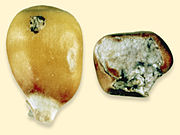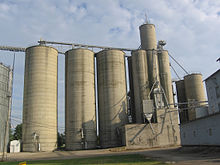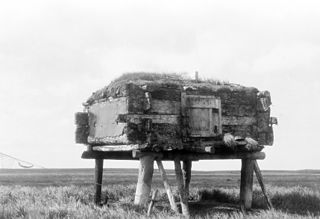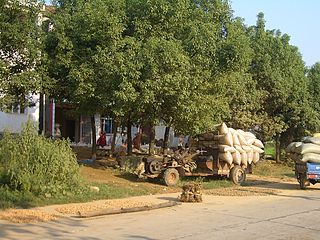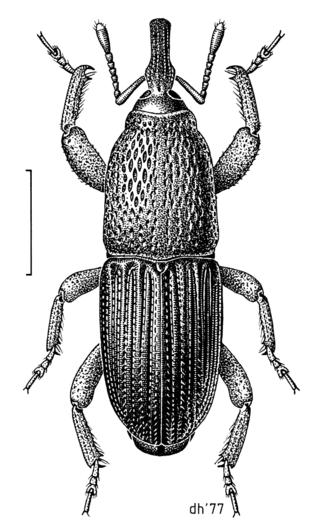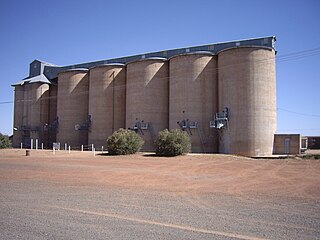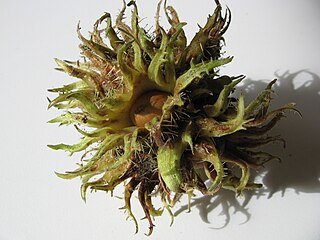Types
Broken/Cracked Kernels

One of the most common form of grain damage is broken or cracked kernels. This is likely to happen during handling processes and transportation.
The USDA lists the cutoffs for broken maize as anything that falls through a 12/64 round-hole sieve, [1] and broken soybeans as anything that falls through an 8/64 round-hole sieve. [2] These standards to do not directly account for any cracks that are present in the seed coat. These cracks in kernels are known to cause deterioration of the grain more quickly through accelerated insect and fungal infestation and a quicker susceptibility to breaking during further handling. [4] The allowable storage time for maize was found to decrease with an increase in mechanical damage (broken/cracked kernels). The storage time was found to decrease as mechanical damage increased from zero to forty percent. [5] With this research, it is necessary to attempt to minimize the amount of mechanical damage in grains. In addition to exterior cracks, stress cracks can form inside of the kernel. These stress cracks usually come from the combination of thermal and mechanical handling processes, such as drying. Kernels with internal stress cracks are found to have a higher breakage susceptibility and can break more quickly during further handling. [6]
- Measuring Broken/Cracked Kernels
There are many methods available for determining mechanical grain damage. The simplest method involves visible inspection of the grain. The USDA lists the threshold for broken grain to be anything that will fit through a 12/64 and 8/64 inch round-hole sieve for maize and soybeans respectively as listed above. This does not account for any cracks or defects in the leftover grain itself.
In 1976, Chowdhury and Buchele developed a Numerical Damage Index for maize. [7] They proposed a system that characterized the damage to each kernel on a scale from D1 (no defects) to D5 (very severely damaged). The procedure then takes a weighted average of the number of kernels assigned to each level to obtain a standardized measure of mechanical damage. This approach is based on visual observations, which carry with them a large amount of variability due to the individual conducting the test.
Other researchers have attempted to measure mechanical damage in more concrete ways. One method is to use a dye that will adhere only to the broken areas of the kernel. From there, the dye is washed off with some type of solvent and measured using a colorimetric technique. [8] A more recently developed technique uses the dielectric properties of the grain to measure the damage level; this method proved to very accurately measure the number of damaged kernels. [9]
Fungal and insect infestation
Fungal and insect infestations can cause dry matter losses which in turn make the grain less valuable. [10] Insect infestation and growth of fungi (including mold) go hand in hand, as many insects actually feed on the storage molds created through the deterioration of grain. [10] Insect infestations can result in not only grain damage as understood by shorter storage times, but can also affect the actual weight of the grain, leading to lower prices at market. In addition, these problems can reduce the nutritional or chemical value of the grain, which can be very important based on the end use. [11] Mold growth can be triggered by moisture, mechanical damage, storage temperature, and other factors. [12] Mycotoxins refers to the toxic fungal chemicals that grow on crops. Of these, the most researched of these is aflatoxin, which have the potential to be carcinogenic (cancer-causing). [13]
- Identifying fungal and insect infestation
The appearance of mycotoxins in grain may have different affects. Some noticeable effects include color changes or mold spots as shown in the images, or even an odor coming from the grain. However, more underlying effects of fungal infection may be subtle and hard to notice without testing. As with broken and cracked kernels, mold damage is usually graded on a visual inspection basis, which can be subjective and have a large variation. Ng et al. used a machine vision method of evaluating mold damage by calculating the number of pixels in an image of grain that included mold, and representing that as a fraction of the total surface area. [14] Infestation by insects such as the maize weevil can sometimes be easier to identify visually, but difficult to quantify on a large scale.
Damage caused by pests
| | This section needs expansion. You can help by adding to it. (June 2017) |
Moths are common pests of grain storage facilities, and are most often found when the grain is stored improperly. Species such as Pyralis farinalis live in grain silos where moisture has been able to infiltrate the grain supply. These moths will lay their eggs in the grain and all parts of the grain will be eaten by the caterpillars after they hatch. [15]
Rats and mice may also damage stored grain.
Heat damage

Heat damage most likely comes from drying of grain. It is a subset of damage including broken or cracked kernels but is identified as its own type of damage by the USDA. The elevated temperatures used during the drying process to eliminate moisture can have adverse effects on the kernels themselves. The most common signs of heat damage include breakage/cracks, discoloration, and shrinkage. When grain goes through the drying process, temperature and moisture gradients in the grain which can cause stress cracks both on the interior and exterior of the kernels. [16] These cracks can pose problems for grain quality as listed in the two previous types of grain damage.
Brown et al. showed that as moisture content increases, the percentage of stress-cracked kernels also increases for multiple types of drying. [17] Some research has also been done on the effect of different types of convective dryers. Jayas and Ghosh found that the percentage of stress cracked kernels was largest with cross-flow driers and smallest with concurrent-flow dryers. [16]
- Measuring heat damage
Heat damage can be measured in a number of ways. First of all is always visual inspection. A noticeable change in color is a distinct effect of heat damage. Some researchers have developed their own methods for identifying color differences through the use of what they call a color difference meter. [18] This meter measures color by three parameters based on lightness and darkness of the sample. A more recent method of assessing heat damage has been created for wheat by Wang, Dowell, and Chung using near-infrared spectroscopy. Their process for using the near-infrared spectroscopy process could classify heat damaged kernels at a rate of approximately 96 percent accuracy. [19]
